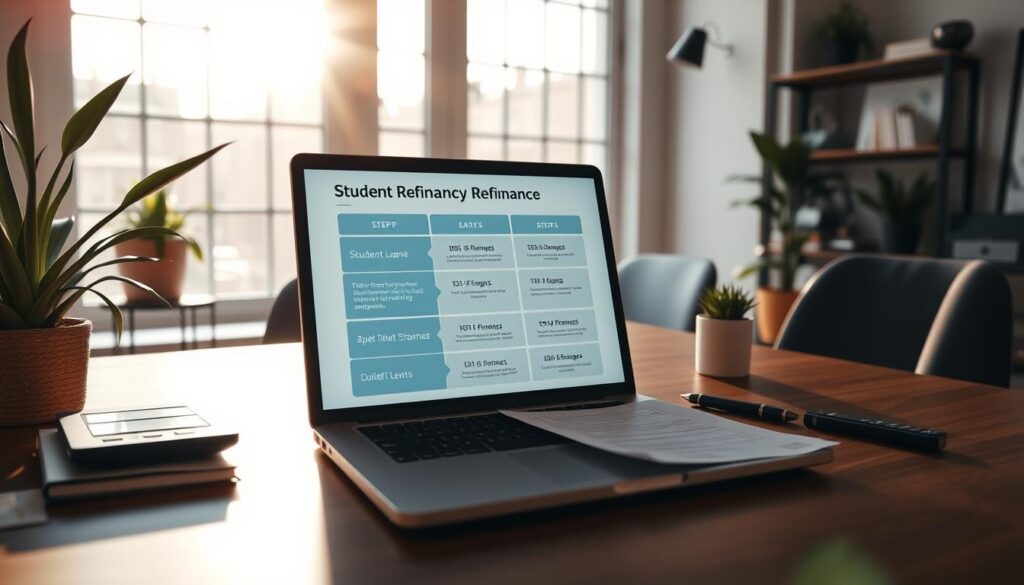Refinancing can cut the cost of higher education debt and reshape monthly payments. This introduction lays out a clear path to decide if a refinance is right for your situation.
We use a common planning benchmark — a 120-month term and a 5.8% average interest rate — to show how rate changes affect the total amount you pay.
This guide explains when refinancing may lower your interest rate, how to compare lenders, and which trade-offs matter for benefits and protections. Gather documents, evaluate your portfolio, and align new payments with income to protect your financial health.
Refinancing differs from consolidation and can change eligibility for federal protections and forgiveness. For complex cases, consult a financial advisor or tax pro before you commit.
Key Takeaways
- Use the 120-month / 5.8% benchmark to estimate savings.
- Compare lenders, terms, and hidden costs before switching.
- Refinance can lower interest but may affect federal benefits.
- Gather documents and plan payments to protect your budget.
- Seek professional advice for unique tax, legal, or health-related impacts.
Refinancing at a Glance: What It Is, Who It’s For, and Why It Matters
When you refinance, a private lender pays off current balances and issues a new loan with fresh terms and a new interest rate.
What refinancing means: It replaces one or more existing student loans with a private loan. The goal is usually a lower rate or simpler monthly billing. Consolidation, by contrast, joins federal loans into a Direct Consolidation Loan without guaranteed rate savings.
Quick benefits and trade-offs: A modest interest cut can reduce total debt and improve cash flow. The trade-off is losing federal protections such as income-driven plans and public service forgiveness.
Key terms to know: Principal is what you borrowed. Interest is the cost to borrow. A grace period is typically about six months after leaving school before payments start. Check federal loan details at the National Student Loan Data System and review private accounts on your credit report at AnnualCreditReport.com.
Eligibility and pricing depend on credit, income, and overall debt profile. Weigh lower interest against the loss of federal benefits to protect your long-term financial health.
When Refinancing Student Loans Effectively Makes Sense
When market rates and your financial picture align, refinancing can trim interest and streamline your repayment plan.
Good fits: Refinance when a lower interest rate will cut the total debt you owe or when combining loans simplifies monthly money management. If your credit has improved and income is steady, you may qualify for better pricing that reduces what you pay over time.

Proceed with caution: Refinancing federal student balances into a private loan may remove access to income-driven repayment, forbearance, deferment, and Public Service Loan Forgiveness. Those in government or in qualifying public service jobs should weigh PSLF rules before switching.
“Keep federal program access in mind—short-term savings can cost you important protections later.”
- Pause if income is variable or you expect to use federal forgiveness or hardship options.
- Consider a shorter term only if cash flow and prepayment plans support it.
- Set clear goals: reduce monthly payments, lower total interest, or accelerate payoff.
How to Refinance Step by Step
Start by gathering a complete list of every active balance and each servicer so you know exactly what you owe and to whom.
Inventory your borrowing
List every federal loans and private loan with servicer name, current balance amount, interest rate, remaining term, and monthly bill. Pull federal records from the National Student Loan Data System and check private accounts via a free credit report at AnnualCreditReport.com.

Check credit, income, and DTI
Review your credit report and score. Verify pay stubs or W-2/1099 and calculate debt-to-income. These items shape your eligibility and the offers lenders will make.
Shop lenders and compare offers
Request quotes from multiple lenders within a short window so credit pulls count as one inquiry. Compare interest rates, fees, repayment periods, autopay discounts (often 0.25%), and any borrower protections.
Apply, confirm payoff, and avoid double payments
Complete the application with accurate documents. If approved, review disclosures and confirm the new lender will pay off each old account.
Keep making existing payments until servicers report a zero balance. Verify accrued interest is included in the payoff and set autopay to capture any discount and protect your on-time history.
| Step | Action | Where to check | Why it matters |
|---|---|---|---|
| Inventory | List balances, rates, servicers, monthly bill | NSLDS & AnnualCreditReport.com | Prevents missed accounts and double payments |
| Compare | Shop lenders, note autopay discounts | Lender quotes (same day) | Find lowest cost and best terms |
| Close | Confirm payoff, start autopay, document plan | Final disclosures & servicer statements | Ensures smooth transfer and protects credit |
Calculate Your Savings and Pick the Right Term
Run side-by-side scenarios to see how different terms change your monthly cost and total interest.
Start by entering your current balance amount, interest rate, and remaining term into a loan calculator. That gives an immediate estimate of monthly payments and total interest under your present plan.
Model refinance scenarios
Use the common 120-month / 5.8% benchmark as a baseline. If your new interest rate is meaningfully lower, total interest paid can drop a lot even when the month-to-month payment looks similar.
Weigh term trade-offs
- Shorter terms raise payments but reduce total interest and speed payoff.
- Longer terms lower monthly outlay but increase interest and extend debt time.
- Compare 5-, 8-, and 10-year options to balance cash flow and aggressive payoff.
Factor in autopay discounts (often 0.25%) and test refinancing only the highest-rate loans if that cuts interest the most. Document your chosen plan and revisit the model once final lender terms arrive to confirm real savings and feasible repayment month to month.
“A small drop in rate can shave years and thousands off your loan debt if matched with the right term.”
Protect Federal Benefits Before You Refinance
Before you sign a new loan, pause to check which federal protections you might lose.
Understand what you give up
Refinancing federal balances with a private lender can remove access to income-driven repayment, deferment, and forbearance. These options can lower payments when income drops or health and education needs create hardship.
Public service and forgiveness rules
If you work in government or a qualifying public service organization, confirm PSLF and related service loan forgiveness rules. Private refinancing usually makes balances ineligible for those programs.
Get expert advice
Talk with a financial advisor, tax pro, or attorney before you refinance. A professional can show how a refinance changes debt totals, taxes, and long-term repayment plans.
- Compare federal benefits versus private savings side-by-side.
- Consider refinancing only private accounts while keeping federal debt in the federal system.
- Keep written records and check every bill during the transfer to ensure payments post correctly.
“Confirm eligibility for forgiveness and repayment programs before you trade protections for lower rates.”
Optimize Payments After You Refinance
A strong repayment routine turns a lower rate into measurable savings over time.
Create a budget that fits your new payment. Use a simple plan like 50/30/20, pay-yourself-first, or envelope cash systems to align income and expenses with your monthly obligation. Record the new amount and treat it as a fixed bill in your month-by-month plan.
Create a budget that fits your new payment
Write a short budget that reserves the payment first. Prioritize emergency savings and key financial goals so paying student debt does not damage health or other priorities.
Turn on autopay for savings and reliability
Enable autopay to reduce missed payments and often earn a 0.25% interest discount. That small cut lowers total interest and can slightly reduce the amount due next month.
Pay extra and apply it to principal
When possible, pay more than the minimum and tell your servicer in writing to apply extra funds to principal on the target loan. Avoid having the account marked “paid ahead,” which can blunt the effect of extra payments.
- Make biweekly or mid-month top-ups so extra money hits principal sooner.
- Use windfalls, bonuses, or employer contributions to accelerate payoff.
- Audit statements each month and contact the servicer early if money gets tight.
“A consistent plan and small extra payments cut interest and shorten your payoff timeline.”
Conclusion
Conclusion
Close the process with a final cross-check of rates, payoff dates, and program eligibility before you sign.
Use the 120-month / 5.8% benchmark to gauge potential savings and confirm balances in federal databases and your free credit report.
Refinancing can lower interest and speed repayment, but choices should match your debt profile, time horizon, and higher education goals.
Keep federal protections in mind if public service or forgiveness programs matter to your job or school path.
Follow a simple plan: gather records, compare net costs, and preserve flexibility by refinancing only what helps reduce loan debt most.
If questions remain, consult a financial advisor to get tailored guidance before you commit.
FAQ
What does it mean to refinance federal student loans and how is it different from consolidation?
Refinancing replaces one or more existing education loans with a new private loan, often to get a lower interest rate or different term. Consolidation, when done through the Department of Education, combines federal loans into a single Direct Consolidation Loan while keeping federal protections like income-driven repayment and Public Service Loan Forgiveness. Refinancing into a private loan typically removes those federal benefits.
When is refinancing a good idea?
Refinancing can help when you have high interest rates, steady income, and good credit that can secure a lower rate. It can also simplify multiple payments into one and may improve your credit mix. If you expect to pay off debt faster or lower monthly bills without needing federal repayment protections, refinancing may be a smart option.
When should I avoid refinancing?
Avoid refinancing if you rely on federal safety nets like income-driven repayment plans, deferment or forbearance options, or are pursuing Public Service Loan Forgiveness. Also pause if your income is unstable—losing federal protections can create hardship during job loss or illness.
What key loan terms should I know before applying?
Learn the meaning of principal (the amount borrowed), interest (the cost of borrowing), repayment term (length of the loan), servicer (company that manages payments), and forgiveness (programs that cancel remaining balance under specific conditions). Also check APR, fixed vs. variable rates, and prepayment penalties.
How do I prepare to apply for refinancing?
Gather current loan balances, interest rates, and servicer information. Check your credit score, verify steady income and employment documents, and calculate your debt-to-income ratio. Improving credit and reducing other debts first can secure better offers.
How should I shop lenders and compare offers?
Get prequalified quotes from multiple private lenders to compare interest rates, loan terms, fees, and autopay discounts. Evaluate fixed vs. variable rate offers and check customer reviews for service quality. Don’t focus solely on monthly payment—compare total interest over the loan life.
What happens after approval and how do I avoid double payments?
After approval, the new lender pays off your existing loans directly. Confirm payoff with both your old servicer and the new lender, then verify that automatic withdrawals stop on the old account. Keep proof of payoff until your account shows a zero balance.
How do I calculate potential savings from refinancing?
Estimate monthly payments and total interest based on your loan amount, the new interest rate, and the chosen term. Compare that total interest to your current loan’s projected interest. Shorter terms usually save interest but raise monthly payments; longer terms lower monthly costs but increase total interest.
What trade-offs exist between a lower monthly payment and total interest paid?
Choosing a longer repayment term reduces monthly payments but increases the total interest paid across the loan. A shorter term raises monthly obligations but lowers total interest. Match the term to your budget and long-term financial goals.
What federal benefits do I risk losing by refinancing with a private lender?
Refinancing federal loans privately removes access to income-driven repayment plans, federal deferment and forbearance, and eligibility for forgiveness programs such as Public Service Loan Forgiveness. Review those programs closely before deciding.
How does refinancing affect eligibility for Public Service Loan Forgiveness (PSLF)?
If you refinance federal loans into a private loan, you permanently lose eligibility for PSLF since only federal Direct Loans qualify. If you work in government or nonprofit sectors and expect to rely on PSLF, keep loans federal until you confirm your eligibility and qualifying payments.
Should I consult a financial advisor before refinancing?
Yes. A financial advisor or tax professional can explain how refinancing affects your overall financial plan, tax situations, and long-term goals. They can also help weigh trade-offs between lower rates and the loss of federal protections.
How can I optimize payments after refinancing?
Build a budget that accounts for the new payment, enable autopay to often earn a 0.25% interest reduction, and pay extra toward principal when possible to shorten the term. Avoid staying “paid ahead” and apply windfalls or employer repayment assistance directly to principal to reduce interest.
What documentation will lenders require during the refinancing application?
Expect to provide proof of identity, recent pay stubs or W-2s, tax returns, account statements for current education loans, and employment verification. Self-employed applicants should prepare profit-and-loss statements and 1099s.
Can refinancing help improve my credit score?
Refinancing may improve credit if it reduces your credit utilization and leads to consistently on-time payments. However, a hard credit inquiry and opening a new account can cause a small short-term dip. Over time, responsible repayment typically helps your score.
Are there fees or penalties I should watch for when refinancing?
Some private lenders charge origination fees, late fees, or prepayment penalties. Many do not charge prepayment penalties, but always read the loan agreement to confirm fees and any costs for early payoff.
How long does the refinancing process usually take?
The timeline varies by lender but commonly takes two to six weeks from application to payoff. Faster decisions happen with complete documentation and electronic verification of income and loans.
What happens if my income changes after refinancing?
Private lenders typically offer less flexible hardship options than federal programs. If income falls, contact your servicer immediately to discuss forbearance, deferment, or modified payment plans. Understand the limits and costs of those options before refinancing.
Can I refinance multiple federal and private loans into one new loan?
Yes. Many private lenders allow you to consolidate both federal and private education debt into a single refinance loan. Remember, combining federal loans into a private loan ends federal protections for the amounts refinanced.
How do interest rates (fixed vs. variable) affect my decision?
Fixed rates remain the same over the life of the loan, offering payment stability. Variable rates may start lower but can rise with market changes, increasing monthly payments. Choose fixed for predictability and variable only if you accept rate risk for potential short-term savings.
Where can I get reliable lender comparisons and calculators?
Use lender websites like SoFi, Earnest, and CommonBond for quotes and tools, plus independent calculators from credible sources such as CFPB and Bankrate. Cross-check offers and read customer reviews to assess service quality and terms.

